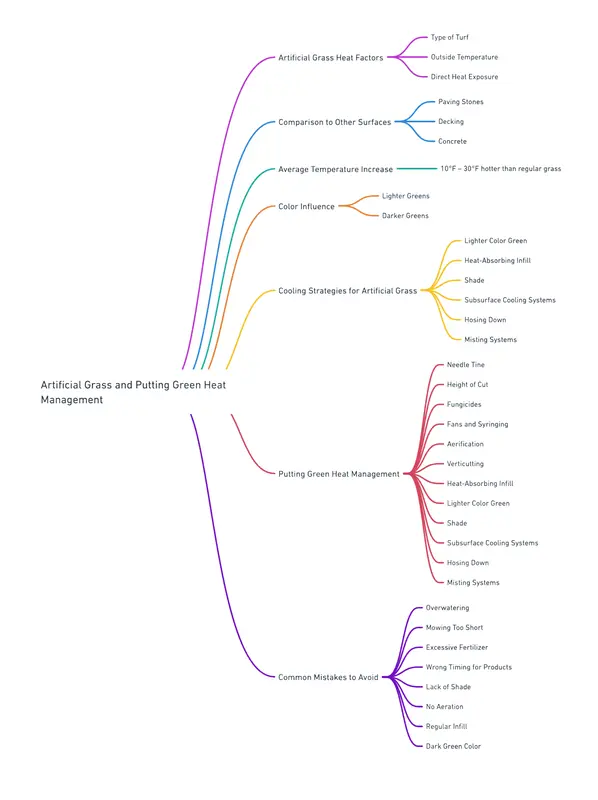Introduction
Ah, the putting green—a golfer’s paradise where precision and skill are put to the test. But as the sun blazes in the summer sky, you might wonder, “Does a putting green get hot?” It’s a valid question, especially when you’re planning to spend hours perfecting your putt. In this article, we’ll delve into the factors that contribute to putting greens getting hot and how to manage the heat effectively.
Section 1: Factors Affecting Putting Green Heat
Type of Turf
First off, let’s talk turf. The type of artificial grass you choose for your putting green can significantly impact how hot it gets. Some materials are more heat-resistant than others, so it’s crucial to consult with experts like us at Wilmington Artificial Turf Pros to make the best choice for your needs.
Outside Temperature
It’s no secret that the hotter it is outside, the hotter your putting green will get. The temperature of the artificial grass is highly dependent on the ambient temperature. So, if you’re experiencing a heatwave, expect your putting green to sizzle too.
Direct Heat Exposure
How much direct sunlight does your putting green get? The more direct heat exposure, the hotter it will become. Consider the positioning of your putting green in relation to the sun’s path to manage heat effectively.
Section 2: Comparison to Other Surfaces
You might be surprised to learn that artificial grass is generally cooler than other common backyard features like paving stones, decking, and concrete. So, if you’re choosing between these options, a putting green could be your coolest bet!
Section 3: Average Temperature Increase
Artificial grass, including putting greens, can be between 10°F – 30°F hotter than regular grass. While this might sound alarming, it’s a manageable increase, especially when you implement the right cooling strategies.
Quick Tips to Beat the Heat
- Choose the Right Turf: Consult experts for heat-resistant options.
- Shade Matters: Install shades or umbrellas for immediate relief.
- Water Works: A quick hose down can lower the temperature instantly.
Section 4: The Influence of Color
Color plays a pivotal role in how hot your putting green can get. Lighter shades of green are less likely to absorb heat compared to their darker counterparts. So, if you’re looking to keep things cool, opt for a lighter hue. It’s not just about aesthetics; it’s also about thermal comfort!
Section 5: Cooling Strategies for Putting Greens
Summer heat got your putting green feeling like a frying pan? Don’t sweat it; we’ve got solutions!
Needle Tine
Start by needle tining your putting green before the summer heat kicks in and every 2-4 weeks thereafter. This helps dry out the surface while increasing oxygen to the roots, making your green more resilient to heat.
Height of Cut
If you notice signs of stress on your putting green, consider adjusting the height of the cut. Raising it slightly can reduce stress and slow down the green speed, offering a quick fix to heat-related issues.
Fungicides
Proper moisture management is key. Use a soil moisture meter to keep tabs on moisture levels. If they’re too low or too high, fungicides can help maintain the balance and keep your green healthy.
Fans and Syringing
Oscillating fans and syringing—applying light amounts of water—can cool the turf canopy effectively. It’s like giving your putting green a mini spa day!
Aerification
Solid tine aerification can open up the surface, allowing oxygen to reach the roots. This prevents the surface from sealing off due to accumulated organic matter.
Verticutting
If your greens are grainy or accumulating too much organic matter, verticutting can be a good option. It involves using vertical knives to cut leaves and stolons, relieving stress on the plant.
Section 6: Common Mistakes to Avoid
Even with the best intentions, mistakes can happen. Here are some common pitfalls to steer clear of:
Overwatering
Too much water can lead to shallow roots, making your putting green more susceptible to heat stress. Remember, moderation is key!
Mowing Too Short
Cutting the grass too short can stress it out and make it more prone to heat damage. Adjust your mowing height according to the season and weather conditions.
Excessive Fertilizer
Applying too much fertilizer can cause rapid growth, leading to heat stress. Stick to the recommended guidelines for a healthy, stress-free green.
Wrong Timing for Products
Timing is everything. Applying products like plant growth regulators or foliar fertilizers at the wrong time can do more harm than good.
Common Mistakes: Quick Summary
- Overwatering: Leads to shallow roots.
- Mowing Too Short: Causes stress.
- Excessive Fertilizer: Promotes rapid growth and heat stress.
- Wrong Timing: Damages the grass.
Conclusion
So, does a putting green get hot? The answer is yes, but it’s a manageable heat. With the right strategies, you can keep your putting green cool and comfortable all summer long. From choosing the right turf and color to implementing effective cooling techniques, there are plenty of ways to beat the heat.
Final Thoughts
Consult professionals like us at Wilmington Artificial Turf Pros for optimal putting green installation and maintenance. We can help you make informed decisions that will keep your green cool, even when the temperature rises.
